
And Then Came Dragons
by Andrew Hall
Dragons are real, folks. This chapter may be hard to get your head around because we’ve been taught dragons are myth. But they are not figments of imagination; they come from the laws of physics. They also come from the bowels of the Earth.
You see, rivers flow where dragons once crawled. As told in countless tales, they are said to come from the sea and the underworld labyrinths. There are so many examples I don’t think I need to quote more than one — but I’ll save that for later. Go discover for yourself. After this article, you will recognize the physics of dragons in the stories of myth. Our ancestors were doing their best to warn us. And yes, dragons are still around. They are just sleeping.
This is a concept some may struggle with, even in the Electric Universe community, because so much of our theories focus on celestial chaos and the electrical havoc wrought by planets in close proximity. We imagine sparks flying, drilling craters into the surface of planets and moons. And there is overwhelming evidence of that, but that is what happens to rocky planets without an active magnetosphere.
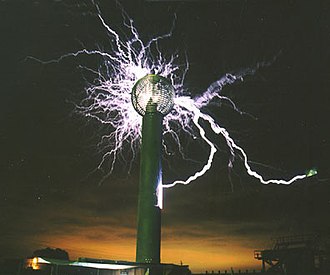
Mars, Mercury, and many pock-marked moons display significant magnetism, but it is mostly remanent, a static artifact of the past electrical activity that scarred them with craters. Planets with dynamic magneto-spheres, atmospheres, and weather like Earth and the gas giants, and even some of the moons, have internal electric circuitry.
Stars and planets are circuits. Three dimensional, standing waves of current and magnetism living in the winds of their parent stars and galaxies. They are a product of inductance and capacitance, potentials and currents, and the magnetic fields current generates. The matter trapped in these 3-D whirlwinds — gas, liquids and dust, and yes, that includes us — is 100% organized by the circuitry.
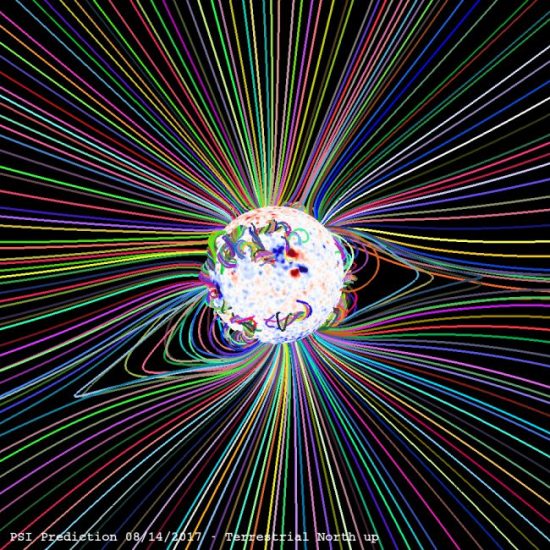
Circuits are cyclic processes. They produce resonant frequencies where signals are amplified and dampened in patterns of constructive and destructive interference. The atmosphere and crust of the planet are essential parts of the circuitry because they provide capacitance — energy storage and regulated energy flow. What follows comes from simply understanding that the circuit flows inside the planet as well as in the atmosphere, plasma-sphere, and magnetosphere, but it is all one circuit, and that is why “things” are so interconnected.
There are feedback loops, oscillations, and high-order harmonic responses that bring order out of chaos, concentrating energy into identifiable, coherent forms. The forms appear all over the place in geology and weather due to the role capacitance plays in the circuit.
In the situation that Earth’s potential is raised (or lowered) in response to some significant celestial event, the crust of the Earth can become saturated with charge. And based on applied science, the most violent discharges in a circuit can be expected through the capacitor. That is because a capacitor builds charge and a voltage across it that is the maximum of the circuit. And when a capacitor blows, it’s the biggest bang of them all. Hence, we have dragons.
A dragon is a type of discharge event from inside the Earth. It’s a short circuit around the continental plates generated by ground currents beneath the plate boundaries. The discharge is reaching for the other side of the plate — the top of the continental ‘mound’ that is forming around the ‘eye of the storm’ where it’s raining rock, dust, and water in a positive ionic mix relative to the current beneath the continental shelf.
Once again, rinse and repeat, this is due to capacitance. In Nature, capacitors aren’t insulated the way we make capacitors. When we make capacitors for electric circuits, we want their actions to be predictable. The last thing we want is a short circuit. So we insulate the edges of capacitor plates to prevent short circuits from plate-to-plate around the dielectric medium.
Nature doesn’t do this. In fact, Nature builds a continental plate as a big dielectric that is thicker in the middle and thinnest at the edge, sandwiched between a deep ground charge and an opposing surface charge.
The edge effect at the periphery of a capacitor plate is called the fringing field. Think of it as a leakage of charge around the edges. That makes it the most likely place to have a discharge. And if current leakage occurs, it will make its way directly to the opposite plate and short circuit the capacitor. Man-made capacitors are insulated around the edges specifically to prevent short circuits in the fringing field.
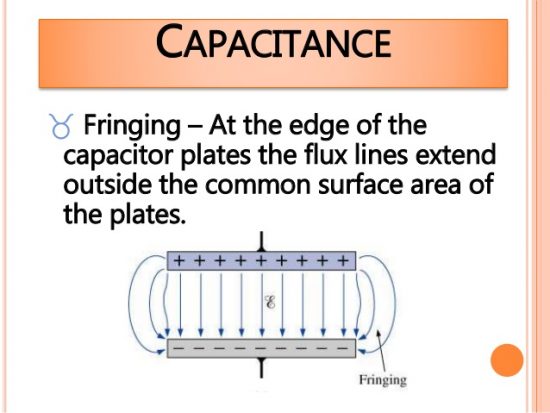
The continental plates aren’t insulated. In fact, the Earth’s crust at the continental boundary — the sea floor — is much thinner, and it lies over the ground current paths. Telluric currents beneath the crust are rivers of current that create the plate boundaries and their magnetic fields create high stress. So the continental plates are structured not to mitigate the fringing effect, but to encourage short circuits — like a relief valve for the energy building below. Dragons are short circuit discharges from the fringing field of the continental plates, discharging through magnetically stressed regions of the sea floor — fracture zones and volcanoes.
There you go. That is what a dragon is. No “magic puff” but a ground-to-ground lightning discharge. Energy building beneath the crust tries to release through volcanoes, belching hot molten matter, heat, lightning, and clouds of ash. But every lava flow adds layers of matter to the capacitor plate. The plate gets wider and thicker and is dancing with surface charge from falling ash, rock, rain, and cooling lava. It’s chemical soup.
Every charged cloud of ash and water vapor forms another chemical soup rising to a stratosphere already charged with plasma. The reaction is plasma storms, of higher ion content than today’s little chubascoes. These storms build surface charge beneath them, on a surface already dancing with energy released from the cooling lava.
And so it goes, charge keeps building across the plate until it short circuits in the fringing field. Essentially the same thing happens in a cloud-to-cloud discharge, where the lightning streaks across the surface of the clouds rather than jumping to ground.
Just think about it, the electric field of the storm is between the ground and clouds. It’s a potential of hundreds of MV, yet much more lightning goes sideways from cloud-to-cloud than from cloud-to-ground.
There is a local voltage difference between clouds that is stronger than the ‘prevailing’ electric field of the storm between cloud and ground. Of course, it is all one field, but the direction of its potential shifts. The field becomes stronger between clouds due to phasing. As clouds discharge lightning, they discharge energy and then rebuild it from the in-flowing winds. This sets up cycles with hysteresis, and two parts of a cloud or two storm cells get out-of-phase with each other, which creates a huge potential.
The arc closes this voltage gap. The path the arc takes predominately follows a surface conductive path at the cloud’s edge, where the condensate boundary forms a layer of charged particles where droplets form.
The same thing happens in ground-to-ground discharge. The subsurface and surface potential difference is oscillating. This especially occurs if the normal path of conductance is blocked, as volcanoes evolve gas chambers of vapor that choke current flow. These oscillations can spike voltage between sub-surface and surface — amplifying ground-to-ground potential — and draw short-circuiting arcs from one side of the continental plate to the other, just like any capacitor would if you stripped the insulation from its edges.
How can we know this is true? Because charge diffusion and discharge take fractal form, and we can identify fractal forms and understand what patterns them — electricity and magnetism.
There is no question rivers take fractal form. Perhaps not every stream of water, because you’ll notice if you pour water downhill, it generally flows straight down whenever it can, and rarely produces a lightning-bolt shaped fractal unless you place rocks strategically in the path of the water the way hydrologists do.
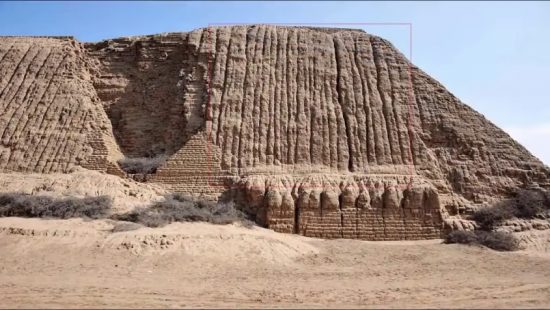
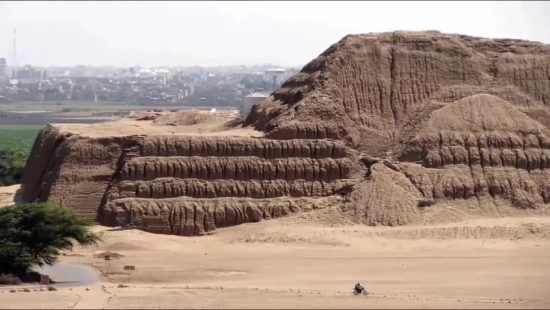
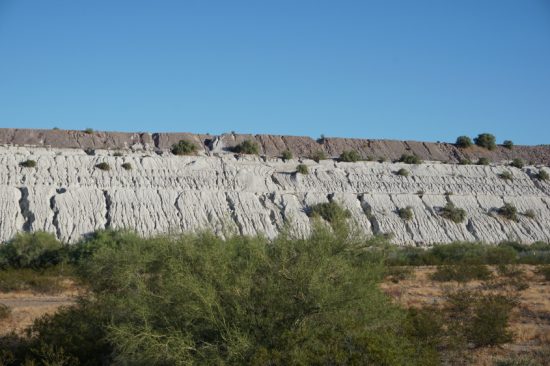
Examine a man-made mountain where natural water erosion is allowed to occur like the mine-tailings pictured. The water erodes straight channels. But natural rivers, like the Amazon, the Congo, and the Colorado River take on the same class of fractal form, called Lichtenberg figures, after Georg Christoph Lichtenberg who first studied them. It is the form that arcing electric discharge takes during dielectric breakdown. Dielectric breakdown is another way of saying “short circuit” in a capacitor.
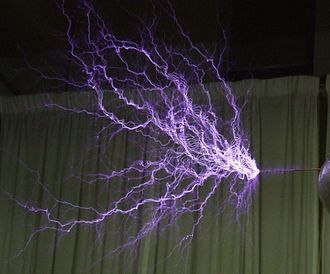
Dielectric breakdown occurs as current paths form in continuously branching, self similar filaments in a process called Diffusion Limited Aggregation (DLA). Brownian motion in a diffusing plasma results in a random walk, where charged particles cluster and grow in dendrite trees, called Brownian Trees. And rivers, in fine and large structure, from head-water to delta, consistently match the variety of branching dendrite forms seen with electric arcs, branching, in multiple self-similar repetitions.
The process is self-similar over time scales as well as dimensions. A dielectric breakdown may occur over years, or nano-seconds, and produce the same dendrite form. Lightning bolts occur in seconds, flashing several times through a channel created by a cascade of electrons reaching for positive ion tendrils growing from the ground. But filaments of discharge in a high voltage insulator grow over months in the manner a crystal grows.
The dendrites expand from a point in ever-smaller self-similarities, spread out in an ever-greater area, or volume over time. They grow in pulses, lightning bolt flashes, as energy pumps into the filament again and again. Until it breaks-through, and establishes continuous current flow, charge advances by combining with, and drawing electrons from its surroundings, which alters the surroundings thermally and chemically, creating channels. Each new pulse follows the channels, wave-guided to the old paths, and extending them forward in self-similar steps until it breaks through.
So a dragon may repeat its route, over and over again, in pulses that may be separated by moments, or millennia.
It’s the Dragon’s Fault
In these select images of the Colorado River, note how much the river follows long straight line segments. Most people are led to believe that rivers are the result of water simply flowing downhill to the ocean, following the path of least resistance. But it is “accepted” scientific consensus that rivers follow faults, and these straight line segments are the visual evidence of it. So water doesn’t “just go downhill”, it follows faults. The obvious question is what causes faults?
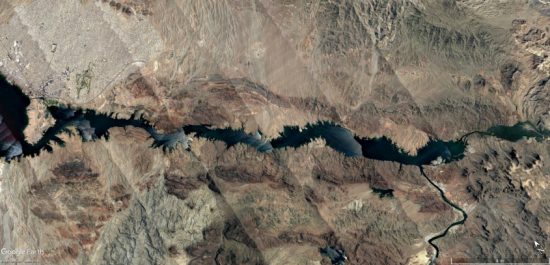
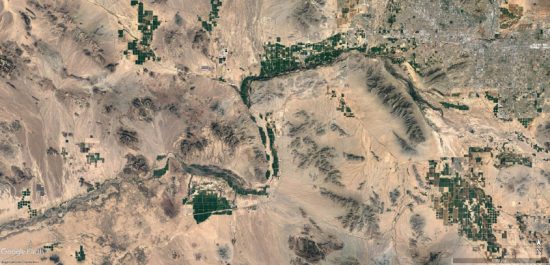
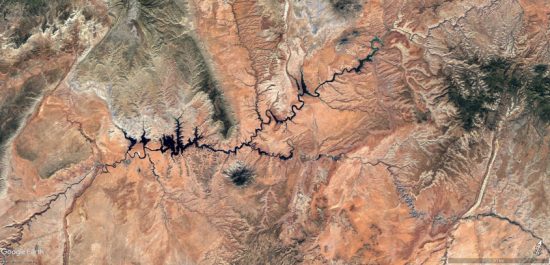
Faults are the dragon’s footprint. Faults are the path of a ground-to-ground discharge. The solid bedrock below is the fused earth from its heat, shock-pressure, diffusing charge, and magnetic field. Its faults, valleys and canyons are what I call the “arc-blasted” zone. ‘Arc blast’ is a term from applied science, whereas ‘dragon’ sounds a bit whimsical. But they are one and the same.
The path of the water flow meanders, but the channel it travels in defines the fault line. Water flows flood and recede, build sandbars, islands, and can change course within the channel.
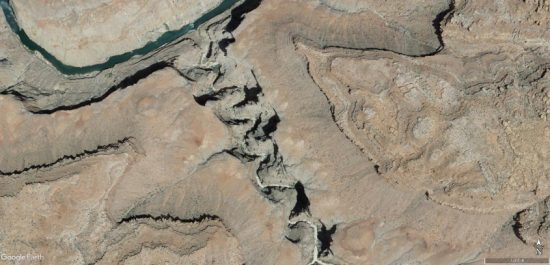
A magnetic footprint accompanies the dragon — as countless magnetic dipole measurements surveyed on rivers around the world attest. River channels have a magnetic signature transverse to the direction of the channel, which is what one should expect from a lightning arc. Shores blackened with magnetite is another testament to a past event when electric current flowed in that channel, wrapped in a magnetic sheath.
Its path is the jagged step-leader shape of a lightning bolt, jumping in straight lines and arcs from point to point, like connecting dots. The path often splits to form tributaries. The angle between the channels provides hints of their cause.
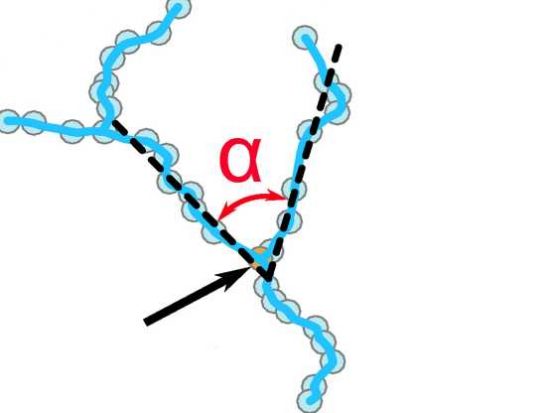
AC/DC — Dragons Go Both Ways
There are several junctions and other features along the Colorado River and its tributaries highlighted in the next image. We’re going to explain each feature.
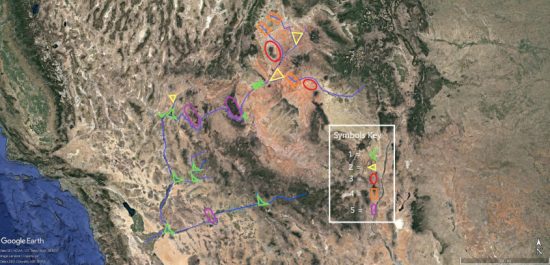
But first, some explanation of what kind of current flows in the Earth. It’s both alternating current and direct current. Alternating current is super-positioned on a direct current carrier wave. Voltage difference is relative, with no absolute positive or negative. This is true of the mineral water, plasma, and solid-state matter that conducts electricity throughout the system, too.
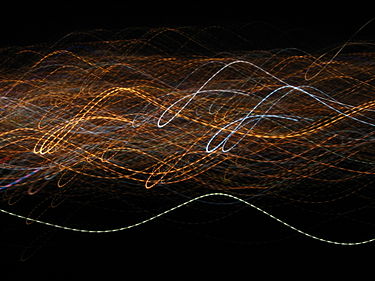
It’s important to understand because Nature doesn’t work with the kind of tidy insulated circuitry and constant voltage, battery-operated predictability that your cell-phone uses. AC circuits oscillate in voltage, current, and impedance as the frequency changes. Everything is dynamic, with feedback and noise adding complexity. But Nature manages to make order from the chaos. The reason is resonance. The beauty of Nature is that it allows malleability in its shape to find the path of least resistance and therefore balance itself out, like water filling a lake. When balance is reached there is resonance.
Dragon Rules
Dragons have rules. They have to play their part in the circuit. And the type of circuit they are part of is what defines the rules. The type of circuit the Colorado River follows is called an RLC circuit.
An RLC circuit combines the fundamental elements of resistor (R), inductor (L), and capacitor (C) connected across a voltage supply. Nature has to comply with physics. So, logic leads to choosing an RLC circuit model since Nature has all three fundamental elements in its makeup. There are parallel and series RLC circuits, and hybrid combinations of those. In the case of the dragon that carved the Colorado River, a parallel circuit is required. The full explanation for why that is will take us into another chapter in Eye of the Storm, but we’ll start with discussing the geometry of junctions.
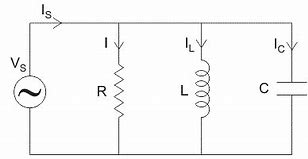
The image highlights nine junctions in green where the Colorado joins its major tributaries. You’ll note they all have a distinctive shape.
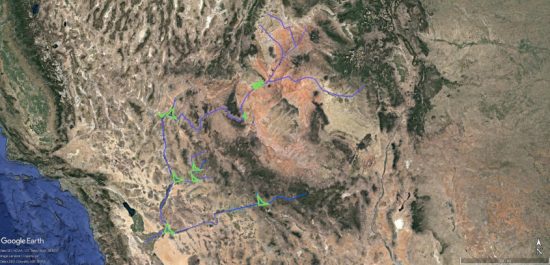
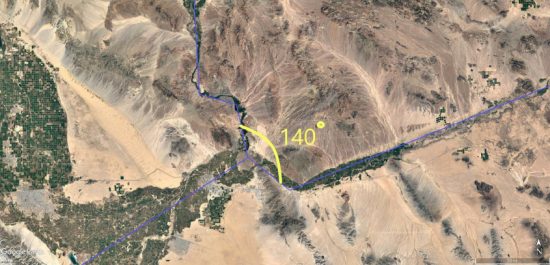
Power in an RLC is not consumed by line resistance alone, but impedance, which has reactive, vector components. The inductor and capacitor elements of the circuit have reactance, which opposes current flow like a resistor, but occurs 90 degrees out of phase with resistance. Inductive current (IL) is at a vector rotated 90 degrees counter-clockwise to the supply line current (IR). Capacitive current (IC) is at a 90 degree rotation clockwise to the line current. The resultant current is not the arithmetic sum of currents, but the vector sum, which produces current at a resultant angle from the original line current.
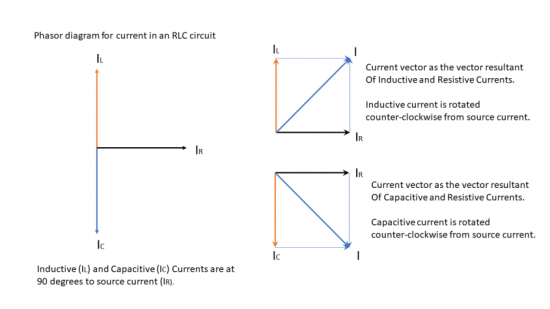
In a parallel RLC circuit, the voltage across each element remains the same and current gets divided. Current shifts vector in a parallel RLC circuit, which is what we see: the river channel splits in two directions, at, or near 180 degrees apart. Keep in mind, rivers flow downhill, but the dragon travels upstream, so a junction is a bifurcation, not a confluence.
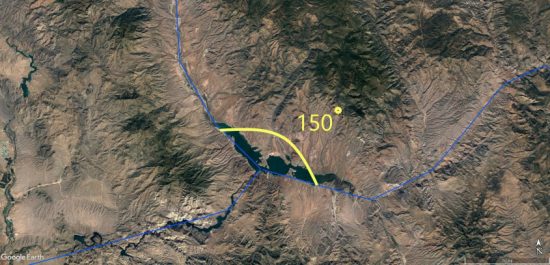
This indicates the current bifurcated because line current went to zero, while capacitive and inductive currents — the reactive currents — initiated current flow along the new vectors. The new vectors are 180 degrees opposed to each other, with the inductive current angled 90 degrees counter-clockwise from the supply line current, and the capacitive current at 90 degrees clockwise from the supply line current, creating a junction shaped like a “T”. This is precisely what happens when a parallel RLC circuit achieves resonant frequency.
Supply line resistance goes up with frequency. As resistance goes up, line current is restricted and reactive current increases. You can visualize reactive current as leakage from a perforated pipe, where more and more fluid (current) escapes through the perforations, shooting out perpendicular to the direction of supply flow if pressure is allowed to build (resistance) inside the pipe.
Resonant frequency causes line resistance to go to infinity. Well, it doesn’t actually go to infinity, but it goes just as high as it needs to stop the line current. When line current goes to zero, reactive current shoots out, like fluid under pressure, perpendicular to the conductor. This is because of Kirchhoff’s Current Law that says the sum of all currents entering a junction is equal to the sum of all currents leaving that junction. Therefore, when resonant frequency is reached, line current cannot overcome resistance and goes to zero. All the current then shoots out as reactive current at vectors 90 degrees from the line current. That is what causes the river to bifurcate in a “T” shape.
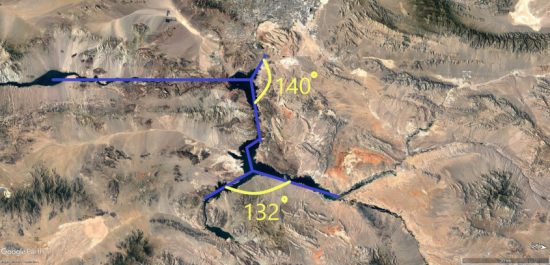
(Note: West is top of page in this image)
Reactive power is commonly considered to be stored power in transmission systems. Inductive reactance stores in a magnetic field and capacitive reactance stores in an electric field. In power grids, we use capacitors and generators to provide these fields to capture the energy and return it to the system. Nature doesn’t have ready-made devices to store energy, so reactive power simply squirts out, at new current vectors, its energy consumed by impedance.
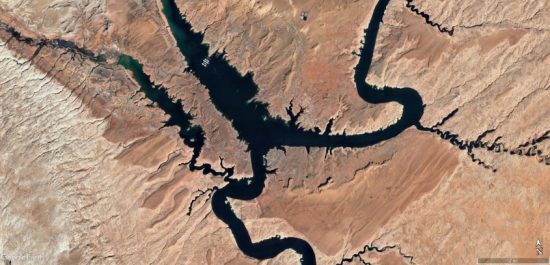
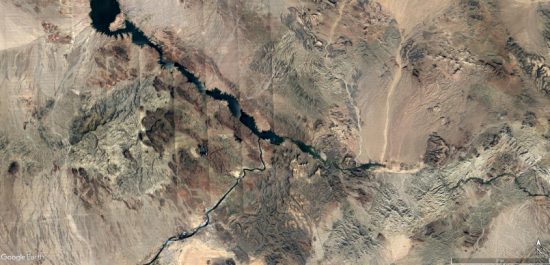
Reactive power is much more complex than water in a pipe. The comparison is meant to illustrate for those who aren’t familiar with the concept. This isn’t the place to review equations, but the basics of RLC circuits and the geometry of reactive power can be found in any circuit fundamentals textbook.
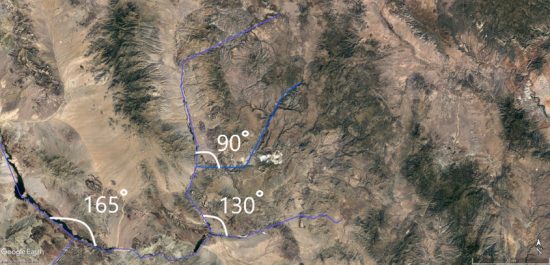
There are a couple of other things to note about the shapes of these junctions. First, they rarely make perfect “T” junctions. Most reactive discharge appears at less than 90 degree rotation from the line voltage, producing a “Y” shape instead of a “T”. This is most likely due to the DC bias in the current. Resonance causes AC line current to go to zero, but not DC. So the resultant current vectors are the vector sum of the total reactive current with the remaining DC line voltage, producing a “Y” instead of a “T”.
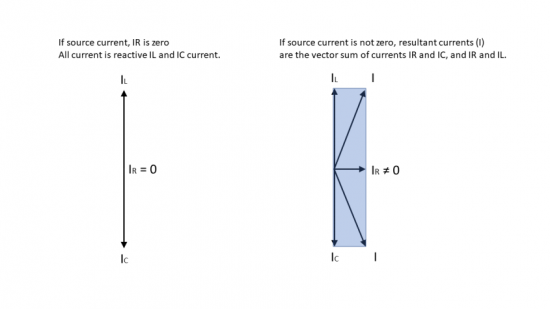
The second thing to note is that the inductive current path (the branch rotated counter-clockwise, or north in the case of the Colorado) continues in that direction more-or-less straight to the next junction, following the north pointing magnetic field.
The capacitive current does something completely different, however, and it does this consistently at every “T” junction: it shoots south a short distance and abruptly curls east, back to the original supply line vector.
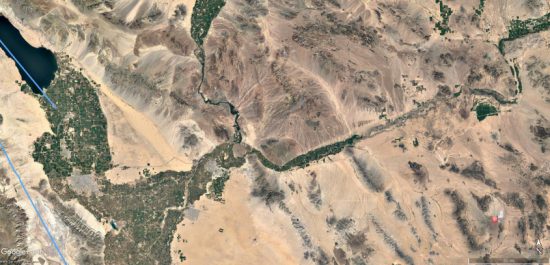
Capacitive current discharges clockwise, to the south of the line current, in a direction 90 degrees from the prevailing electric field in response to a far-field charge build-up. The far-field charge builds in a capacitance response (reactance) to the charge building in the supply line as frequency rises and chokes off supply-line current. But once it discharges, it equalizes charge differentials and the far-field voltage it is responding to disappears. The current immediately turns back to align with the prevailing field – the original supply line current vector. That is why the southern branch always makes an immediate sharp turn eastward and realigns, at least briefly, with the supply current.
This is really important because Nature following precisely a form expected from electrical discharge, and repeating it over and over again, is hard to call coincidence.
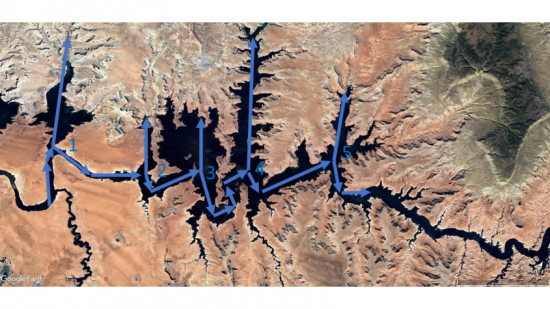
It’s helpful to look at the big picture. If we draw lines to represent the prevailing electric field aligned with the supply line current, it is easy to see that the Colorado River and its tributaries, or more precisely, the dragon that carved the river, is a discharge that follows the electric field in a step-wise manner. Resonant reactive surges bifurcate into inductive current branches that move the discharge north into the strongest voltage lane (C), which aims it to the Eye of the Storm in the four corners region of Northern Arizona and Utah.
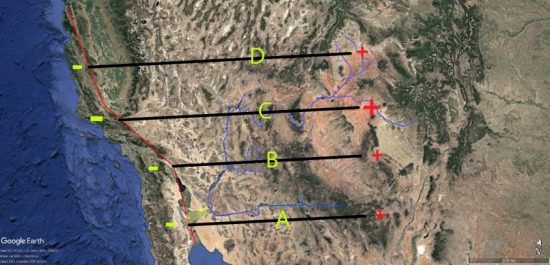
The electric field is between the accumulating material on the Colorado Plateau, and the San Andreas Fault (marked in red.) Why this is will be discussed in the next chapter, but it’s the reason the Colorado is a parallel RLC circuit.
The capacitive current branches all make a brief step to the south, then abruptly turn back east to re-align with the prevailing electric field, first producing the Gila tributary (A), and then the Bill Williams tributary (B). When it reaches the resonant RLC discharge at Lake Meade, it finally found the lane of maximum electric field potential (C), and thereafter shoots east to the Eye of the Storm, centered at Monument Valley, carving some amazing canyons and other features along its way.
In the next chapter of Eye of the Storm, we’ll discuss these canyons, other types of branching, other features, and their likely causes. But before we close this chapter, let’s consider what a dragon looks like.
In myth, references to dragons can be confusing, because sometimes they boil the sea, sometimes they ravage the land, and sometimes they take wing. The discharge that scraped the land in surface conductive arcing also created its own weather and induced following jet-stream winds. Depending on perspective, one might describe a dragon as a submarine, serpent, or flying demon. Following jet stream winds choked with dust, swirling from cyclone to cyclone, had to look like animate serpent bodies glowing with internal lightning.
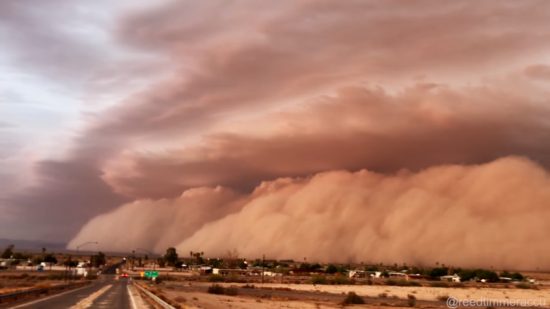
In its early path, it scraped the surface, following surface water laid down by storm and tsunami. Water is its conductor. Just as in the atmosphere, water is the conductor. Like it is in our bodies, and plants, and pretty much all of Nature.
Water is di-polar, and in the field of a strong electric potential, the polarity of its molecules will align coherently and facilitate current. It is liquid, so flows through pores in rock and soil, providing electrical continuity across vast stretches of Earth. Earth’s crust is saturated with water, even deserts, but for the very shallow top layers of sand and mountain.
Water provides the “surface conductance” for the ground-to-ground discharge. So that’s another rule of the dragon, to follow water.
But it doesn’t always follow surface water. The storm that drew forth the Colorado, the storm over the Colorado Plateau, was laying down layer upon layer of dry sediments, burying the lakes, inland seas and their drainage. The dragon burrowed into the ground beneath these dry deposits and followed the water like a tree root.
All along its jagged path, on either side the land was pummeled. A dense magnetic field surrounded the current as it pulsed and sparked. And this drew lightning from the raging plasma clouds above, inducing a following storm system of winds, whirlwinds, and meso-cyclones that conflicted with the ambient winds, creating shock waves all around.
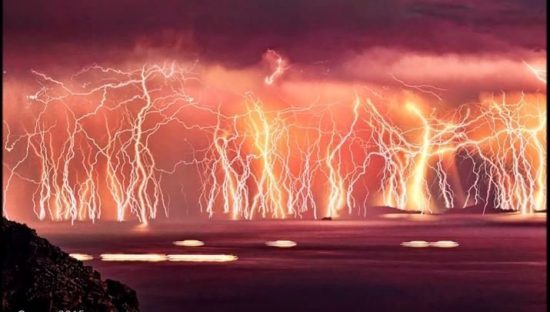
On the ground, whirlwinds at the maw of the beast sucked tons of billowing dust to wrap around the plasma at the core of the arc, filling it’s body within the confines of a magnetic sheath. It formed a lions mane, or feathered appearance at it’s head as it drew in streamers of dust.
The arc advanced in explosive, staccato bangs, jumping from node to node, connecting dots across the landscape. But heavy ionic matter moved more slowly, being either pulled with, or drawn against the current, as dictated by charge polarity. These horizontal whirlwinds might have looked like ultra-high speed trains racing across the land.

It likely wore an inner vest of elemental conductors, and molten silica around a super-heated plasma core. An outer coat of ragged dust, drawn to its maw as it advanced, wrapped tight to its body by ferrous material caught in the magnetic field. Shock waves patterned this cloak into diamond-shaped scales that pulsed with light and x-rays. It spit lightning and flames in seventy-mile arcs, while shock waves boomed from its flanks.
Sounds just like a dragon, huh? But why take my word for it?
Listen to an eyewitness account:
Job 41:12-21
I will not conceal his limbs, His mighty power, or his graceful proportions.
Who can remove his outer coat? Who can approach him with a double bridle?
Who can open the doors of his face? With his terrible teeth all around?
His rows of scales are his pride; Shut up tightly as with a seal;
One is so near another, That no air can come between them;
They are joined one to another, They stick together and cannot be parted.
His sneezings flash forth light; And his eyes are like the eyelids of the morning.
Out of his mouth go burning lights; Sparks of fire shoot out.
Smoke goes out of his nostrils; As from a boiling pot and burning rushes.
His breath kindles coals; And a flame goes out of his mouth.
Job 41:30-34
His undersides are like sharp potsherds; He spreads pointed marks in the mire.
He makes the deep boil like a pot; He makes the sea like a pot of ointment.
He leaves a shining wake behind him; One would think the deep had white hair.
On earth there is nothing like him; Which is made without fear.
He beholds every high thing; He is king over all the children of pride.
That’s the bible folks. And it’s not talking about a fish, or a whale. Leviathan in the Bible is a dragon, much like the other demigods from the sea in every ancient tradition.

There are ten chapters for the Eye of the Storm series. This is Chapter Seven. Chapter Eight will discuss more about dragons and the rules they live by. Chapter Nine will delve under the crust of the Earth to see what’s there, and Chapter Ten will summarize all that we have discussed and conclude this examination of the Colorado Plateau.
In the end, if you read and comprehend all ten chapters and study circuit theory, you will have the tool, wisdom that is, to evaluate your part of the world on your own.
Come join the club.
Additional Resources by Andrew Hall:
YouTube Playlists through 4-2022:
Andrew Hall — EU Geology and Weather
Andrew Hall — Eye of the Storm Episodes (13)
Surface Conductive Faults | Thunderblog
Arc Blast — Part One | Thunderblog
Arc Blast — Part Two | Thunderblog
Arc Blast — Part Three | Thunderblog
The Maars of Pinacate, Part One | Thunderblog
The Maars of Pinacate, Part Two | Thunderblog
Nature’s Electrode | Thunderblog
The Summer Thermopile | Thunderblog
Tornado — The Electric Model | Thunderblog
Lightning-Scarred Earth, Part 1 | Thunderblog
Lightning-Scarred Earth, Part 2 | Thunderblog
Sputtering Canyons, Part 1 | Thunderblog
Sputtering Canyons, Part 2 | Thunderblog
Sputtering Canyons, Part 3 | Thunderblog
Eye of the Storm, Part 1 | Thunderblog
Eye of the Storm, Part 2 | Thunderblog
Eye of the Storm, Part 3 | Thunderblog
Eye of the Storm, Part 4 | Thunderblog
Eye of the Storm, Part 5 | Thunderblog
Eye of the Storm, Part 6 | Thunderblog

Andrew Hall is a natural philosopher, engineer, and writer. A graduate of the University of Arizona’s Aerospace and Mechanical Engineering College, he spent thirty years in the energy industry. He has designed, consulted, managed, and directed the construction and operation of over two and a half gigawatts of power generation and transmission, including solar, gasification, and natural gas power systems. From his home in Arizona, he explores the mountains, canyons, volcanoes, and deserts of the American Southwest to understand and rewrite an interpretation of Earth’s form in its proper electrical context. Andrew was a speaker at EU2016, EU2017 and the EUUK2019 conferences. He can be reached at hallad1257@gmail.com or thedailyplasma.blog
Disclosure: The proposed theories are the sole ideas of the author, as a result of observation, experience in shock and hydrodynamic effects, and deductive reasoning. The author makes no claims that this method is the only way mountains or other geological features are created.
The ideas expressed in Thunderblogs do not necessarily express the views of T-Bolts Group Inc. or The Thunderbolts Project.












